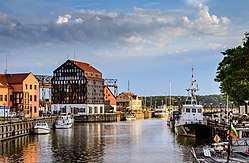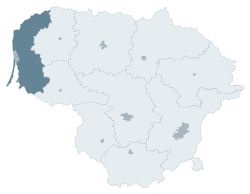Klaipėda County
Klaipėda County (Lithuanian: Klaipėdos apskritis)[2] is one of ten counties in Lithuania, bordering Tauragė County to the southeast, Telšiai County to the northeast, Kurzeme in Latvia to the north, and Kaliningrad Oblast in Russia to the south. To the west is the Baltic Sea. It lies in the west of the country and is the only county to have a coastline. Its capital is Klaipėda. On 1 July 2010, the county administration was abolished,[3] and since that date, Klaipėda County remains as the territorial and statistical unit.
Klaipėda County Klaipėdos apskritis | |
|---|---|
 | |
 Flag  Coat of arms | |
 Location of Klaipėda County | |
| Country | |
| Administrative centre | Klaipėda |
| Municipalities | |
| Area | |
| • Total | 5,222 km2 (2,016 sq mi) |
| (8% of the area of Lithuania) | |
| Population (2020-01-01) | |
| • Total | 319,958 |
| • Rank | 3rd of 10 (11.4% of the population of Lithuania) |
| • Density | 61/km2 (160/sq mi) |
| Time zone | UTC+2 (EET) |
| • Summer (DST) | UTC+3 (EEST) |
| ISO 3166 code | LT-KL |
| GDP (nominal) | 2017 |
| - Total | €4.8 billion (US$5.4 billion) |
| - Per capita | €15,100 (US$16,800) () |
| HDI (2018) | 0.871[1] very high · 3rd |
Geography
The topography of Klaipėda County is divided into three regions, the highest in the east and lowest in the west: the Western Zemaičiai Plateau in the east, the Western Zemaičiai Plain in the center, and the Pajurys Lowland in the west and on the Baltic coast.
Klaipėda County borders Kaliningrad Oblast, Russia, to the south via the Nemunas, which drains into the Curonian Lagoon. The Curonian Spit, a UNESCO World Heritage Site, is split between Klaipėda County, Lithuania and Kaliningrad Oblast, Russia. The Lithuanian side of the spit is separated from mainland Lithuania via a small opening between Klaipėda and Smiltynė where the Curonian Lagoon drains into the Baltic Sea.
Municipalities
Municipalities are:
| Klaipėda City Municipality | |
| Klaipėda District Municipality | |
| Kretinga District Municipality | |
| Neringa Municipality | |
| Palanga City Municipality | |
| Skuodas District Municipality | |
| Šilutė District Municipality |
Demographics
As of 2020, Klaipėda County's population was 319,958. Approximately 69% is urban, while the remaining 30% are rural. It is the third most populous county in Lithuania.
Gender
As of 2020, approximately 52% of people are female and 47% are male.
Ethnic groups
The ethnic composition in 2001 was:[4]
- Lithuanians 84.2%
- Russians 11.4%
- Ukrainians 1.3%
- Belarusians 1.0%
- Poles 0.3%
- Other 1.8%
References
- "Sub-national HDI - Area Database - Global Data Lab". hdi.globaldatalab.org. Retrieved 2018-09-13.
- "Counties within Lithuania - weather and maps", TravelsRadiate, accessed Feb 15, 2011.
- "Dėl apskričių viršininkų administracijų likvidavimo". Seimas of the Republic of Lithuania. Retrieved 21 August 2011.
- "Archived copy" (PDF). Archived from the original (PDF) on 2012-01-05. Retrieved 2012-01-12.CS1 maint: archived copy as title (link)
External links
- Social and demographic characteristics of Klaipėda County
- Economy of Klaipėda County
- Environment of Klaipėda County